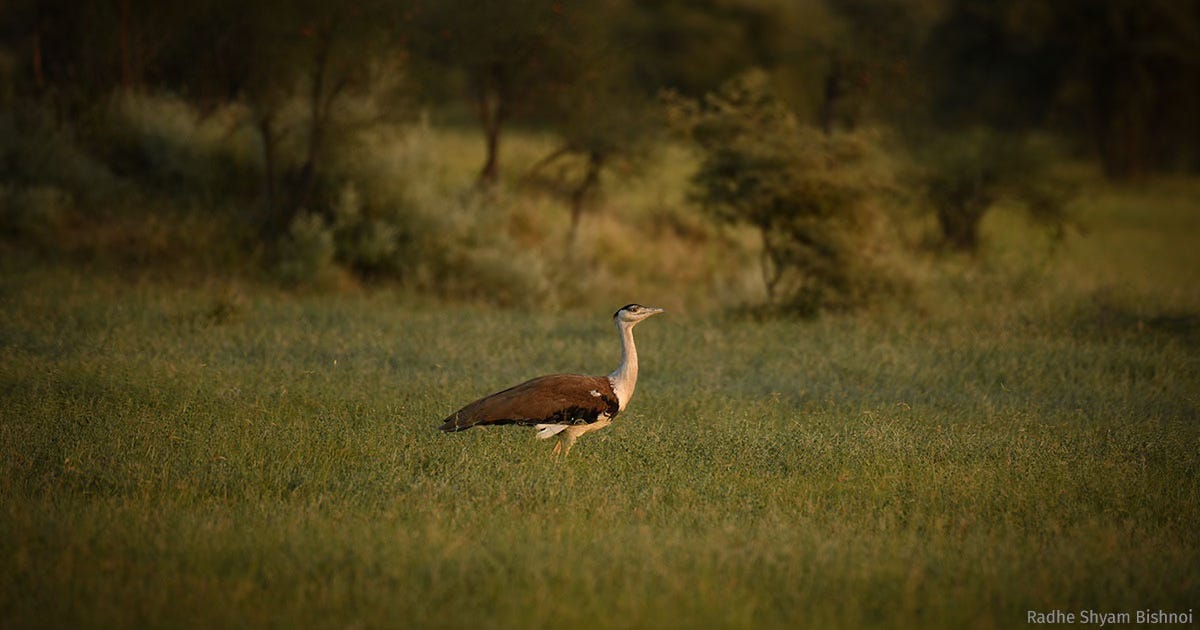The Vanishing Of The Great Indian Bustard
Also this week, how a cycle of poverty is pushing women in Assam's tea gardens to the brink, and the rising toll of India's road accidents
Sometime in the 1920s, wolves were totally eliminated from America’s famed Yellowstone National Park, on the grounds that they were a clear and present threat to both humans and animals.
Cue the law of unforeseen consequences. The elk population grew exponentially; they eat grass and shrubs and denude trees, with the result that the ecosystem was affected. Grizzly bears, also native to the park, found that their supply of berries was also eaten by elks. This degradation of the environment ramified in all sorts of ways, all of which contributed to the decline of the park itself.
In 1995, wolves were reintroduced into the park with dramatic results, as detailed in this National Geographic documentary.
This is what we don’t, as a people and as policymakers, get. When environmentalists point to endangered habitats and to depleting local fauna, the practice is to dismiss them as “woke”, as “anti-development”. What is absent from such conversations is the realisation that in Nature, everything is interconnected—too much or too little of one species of flora or fauna has knock-on detrimental effects on entire ecosystems. Absent this understanding, each instance of a species under threat is seen in isolation, and consequently not treated with the seriousness it deserves.
The Great Indian Bustard’s Struggle for Survival
Around the time wolves were being eliminated from Yellowstone, the Great Indian Bustard was plentiful across large swathes of central, western and southern India and Pakistan.
As India developed, the GIB’s natural habitats came under increasing threat. Grasslands, critical to the survival of GIBs and other species, became reclassified as wastelands—and governmental efforts were aimed at maximising their productivity, either through the spread of agriculture, or through construction.
Power transmission lines across their habitats, and more recently the deployment of solar panels over large tracts, had the unforeseen result of shrinking their habitats in India, and triggering the GIBs increased migration to Pakistan—where the bird, which weighs 15 kg or more, is hunted for its meat.
Long story short, the GIB was listed as a critically endangered species on the International Union for Conservation of Nature red list as far back as 2011. Thirteen years later, as Sneha Richhariya points out in this reported piece, the Great Indian Bustard’s fate has only become more dire – with knock-on consequences for those ecosystems that are their natural habitat.
How Poverty Perpetuates Trafficking in Assam’s Tea Gardens
In Kerala, a state that has a history of treating its migrant labour well, a worker in a tea plantation is paid Rs 482 per day. The work is back-breaking, and the wage is commensurate with the effort.
In Assam, where tea is one of the biggest revenue earners, the situation is the opposite. A plantation worker who labours for between 8-12 hours a day and is expected to collect anywhere between 12-60 kg of tea leaves per day (the large variance is season-dependent) is paid between Rs 150-250 per day, the variance depending on the size of the tea estate.
Besides low wages, tea plantation workers in Assam face other existential issues such as minimal access to healthcare and to schooling. The former impacts on the ability to work; the latter leads to high dropout rates, particularly among young girls.
All of this in turn leads to workers—particularly the men—migrating in search of jobs in construction and other industries. And that leaves the women, who are left behind, vulnerable to exploitation, particularly sexual exploitation at the hands of traffickers who lure vulnerable women and young girls with the promise of better-paying jobs.
Maitreyee Boruah’s ground report sheds light on a growing issue that gets little or no airplay in mainstream media.
Death on Four Wheels
The Hindi edition of IndiaSpend looks at an increasingly alarming phenomenon: As we continue to build highways and superhighways at speed, the number of deaths due to road accidents is increasing exponentially.
One statistic sums up the problem: Official figures show that one death is recorded for every 2.5 km of highway.
Parikshit Nirbhay explores the reasons behind the increasing toll our highways are taking on human life.





